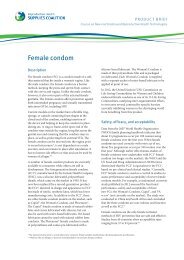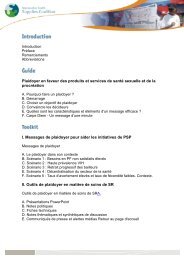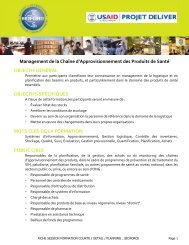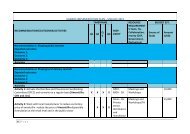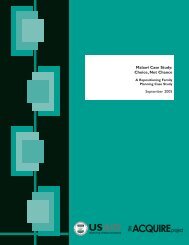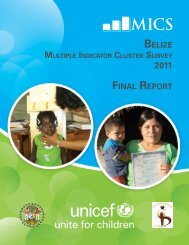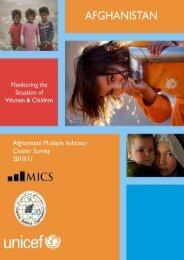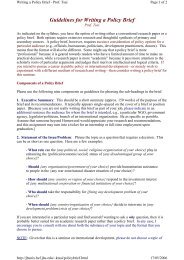EVERY WOMEN EVERY CHILD UN COMMISSION ON LIFE-âSAVING
EVERY WOMEN EVERY CHILD UN COMMISSION ON LIFE-âSAVING
EVERY WOMEN EVERY CHILD UN COMMISSION ON LIFE-âSAVING
- No tags were found...
Create successful ePaper yourself
Turn your PDF publications into a flip-book with our unique Google optimized e-Paper software.
1. BACKGRO<strong>UN</strong>D .................................................................................................................. 4 1.1 INTRODUCTI<strong>ON</strong> ....................................................................................................................... 4 1.2 THE UGANDA C<strong>ON</strong>TEXT ............................................................................................................ 4 1.3 PROCESS OF DEVELOPMENT OF THE UGANDA PLAN ......................................................................... 8 1.4 PRIORITY MEDICINES FOR UGANDA ............................................................................................. 9 1.4 PRIORITY RECOMMENDATI<strong>ON</strong>S FOR UGANDA ................................................................................ 9 2. OVERALL GOAL ................................................................................................................ 9 3. UGANDA COMMODITY SPECIFIC IMPLEMENTATI<strong>ON</strong> PLAN ............................................... 9 3.1 REPRODUCTIVE HEALTH COMMODITIES ..................................................................................... 10 3.1.1 Female Condom ......................................................................................................... 10 Problem statement ................................................................................................................ 10 Specific issues identified ........................................................................................................ 10 Implementation plan ............................................................................................................. 10 3.1.2 Contraceptive Implants .............................................................................................. 11 Problem statement ................................................................................................................ 11 Specific issues identified ........................................................................................................ 11 Implementation plan ............................................................................................................. 12 3.1.3 Emergency Contraceptive Pill .................................................................................... 13 Problem statement ................................................................................................................ 13 Specific issues identified ........................................................................................................ 13 Implementation plan ............................................................................................................. 13 3.2 MATERNAL HEALTH COMMODITIES ........................................................................................... 13 3.2.1 Misoprostol for prevention and treatment of PPH .................................................... 14 Problem statement ................................................................................................................ 14 Specific issues identified ........................................................................................................ 14 Implementation plan ............................................................................................................. 15 3.2.2 Magnesium Sulphate for prevention, treatment of severe pre-‐eclampsis and eclampsia .............................................................................................................................. 15 Problem statement ................................................................................................................ 15 Specific issues identified ........................................................................................................ 16 Implementation plan ............................................................................................................. 16 3.2.3 Oxytocin injection for prevention and treatment of PPH .......................................... 17 Problem statement ................................................................................................................ 17 Specific issues identified ........................................................................................................ 17 Implementation plan ............................................................................................................. 17 3.3 NEWBORN HEALTH COMMODITIES ........................................................................................... 18 3.3.1 Antenatal Corticosteroids for management of preterm labor .................................. 18
Problem statement ................................................................................................................ 18 Specific issues identified ........................................................................................................ 18 Implementation plan ............................................................................................................. 19 3.3.2 Injectable Antibiotics for Neonatal Sepsis .................................................................. 19 Problem statement ................................................................................................................ 19 Specific issues identified ........................................................................................................ 20 Implementation plan ............................................................................................................. 20 3.3.3 Newborn Resuscitation Devices ................................................................................. 21 Problem statement ................................................................................................................ 21 Specific issues identified ........................................................................................................ 21 Implementation plan ............................................................................................................. 21 3.3.4 Chlorohexidine for Cord Care ..................................................................................... 22 Problem statement ................................................................................................................ 22 Specific issues identified ........................................................................................................ 22 Implementation plan ............................................................................................................. 22 3.4 <strong>CHILD</strong> HEALTH COMMODITIES .................................................................................................. 23 3.4.1 Oral Rehydration Salts and Zinc treatment Diarrhea ................................................ 23 Problem statement ................................................................................................................ 23 Specific plan .......................................................................................................................... 23 Implementation plan ............................................................................................................. 24 3.4.2 Amoxicillin tablets for treatment of pneumonia in children ..................................... 26 Problem statement ................................................................................................................ 26 Specific issues identified ........................................................................................................ 26 Implementation plan ............................................................................................................. 27 MANAGEMENT AND COORDINATI<strong>ON</strong> ARRANGEMENTS ........................................................ 28 REFERENCES ........................................................................ ERROR! BOOKMARK NOT DEFINED. UGANDA IMPLEMENTATI<strong>ON</strong> PLAN – <strong>UN</strong>COLSC 2013 ............................................................. 31
1. BACKGRO<strong>UN</strong>D 1.1 Introduction The United Nations Commission on Life-‐Saving Commodities (<strong>UN</strong>CoLSC) was created by the <strong>UN</strong> Secretary-‐General, Mr. Ban Ki-‐moon, under the auspices of the Every Woman Every Child (EWEC) movement, and seeks to amplify efforts to save and improve the lives of 16 million women and children. This Commission aims to promote consensus around thirteen (13) affordable and effective medicines and health supplies that currently do not reach the women and children who most need them, by providing a platform to help overcome major bottlenecks. It is estimated that scaling up these 13 commodities over five years would cumulatively save over 6 million lives including 230,000 maternal deaths averted through increased access to family planning; save an extra 1.8 million child deaths a year, reducing the estimated 7.1 million deaths in 2010 to 5.3 million. Three commodity-‐specific types of barriers prevent women and children from receiving appropriate interventions: (1) the insufficient supply of high quality health commodities; (2) the inability to effectively regulate the quality of these commodities; and, (3) the lack of access and awareness of how, why and when to use them. Ten recommendations to address these barriers to access to and utilisation of the 13 essential commodities have been identified. Uganda is a signatory to the Abuja meeting ministerial communiqué committing to implement the 10 <strong>UN</strong> commission recommendations. . 1.2 The Uganda context While Uganda has made some progress towards the attainment of MDG 4 and 5, the rate of reduction is slow, compared to the set MDG target of 54 per 1000 live births and 131 per 100, 000 by the year 2015, respectively. U5MR has reduced from 137/1,000 live births in 2006 to 90 in 2011, and IMR has reduced from 90/1000 to 54/1000 live births in the same period (UDHS 2006; 2011). Similarly MMR has reduced from 505 to 435 deaths per 100,000 live births. Yet more than 200,000 children under-‐five years die every year mainly due to preventable conditions especially malaria, pneumonia, diarrhea, vaccine-‐preventable diseases (e.g. measles), HIV/AIDS, and neonatal conditions. The leading direct causes of maternal deaths are hemorrhage (26%), sepsis (22%), obstructed labor (13%), unsafe abortion (8%) and hypertensive disorders in pregnancy (6%). The major challenge in Uganda is the high fertility rate with a total fertility rate of 6.6 (UDHS 2011). This drives the other burdens namely pre-‐term delivery, post partum haemorrhage,
sepsis, pre-‐eclampsia and eclampsia. There is poor coverage of Family Planning services especially in the hard-‐to-‐reach areas with unmet need for Family Planning stands at 41%, moslty as a result of inadequate access of young people to contraceptives and inadequate use of long acting and permanent methods. Another major problem concerns newborn deaths, which have maintained the high-‐sustained levels of the IMR, making it impossible for Uganda to achieve the MDG 4 target of reducing by two-‐thirds the mortality rate among children under-five by 2015. According to the Uganda newborn situation analysis of 2008, 39% and 25% of deaths among infants and children under-‐five, respectively, are under 28 days of life. The majority of these deaths result from preventable causes like infections, birth asphyxia or injuries and complications of prematurity. A related problem is early, unplanned and unwanted pregnancy with evidence of high incidence of unsafe abortions and its related complications in the age group. The Uganda road map for acceleration of reduction of Maternal and Neonatal Morbidity and Mortality, the Reproductive Health Commodity Security Strategy and the National Child Survival Strategy were formulated in 2007, 2008 and 2009, respectively. With regard to newborn health, a detailed framework on newborn health was developed to operationalize the newborn health component of the Child Survival Strategy. In an attempt to bring services closer to the people the community treatment of malaria, pneumonia and diarrhea policy, through use of village health teams was adopted in 2010. The effective implementation of these strategies is expected to contribute significantly towards achievement of MDGs 4 and 5 by 2015. The Uganda National Drug Policy is operationalized through the Pharmaceutical Sector Strategic Plan, and aims at ensuring the availability and accessibility of adequate quantities of affordable, efficacious, safe and good quality essential medicines to all. The public sector national medicines procurement is mainly through National Medical Stores (NMS), a parastatal organization, while the Joint Medical Stores (JMS) is the major PNFP sector supplier for medicines and health supplies. The National Drug Authority (NDA) is responsible for regulating the pharmaceutical market, licensing premises, drug information, pharmaco-‐vigilance, quality assurance, import permissions and disposal of expired medicines but has a limited capacity with insufficient outreach. Global initiatives provide the bulk of reproductive health commodities. Government of Uganda distributes life saving commodities free of charge through the public health system. The public health system includes National referral Hospitals, Regional Referral Hospitals, General Hospitals, Health Centres IV, III, and II and community based distributors. 1.2 Problem Statement Major health system challenges still remain to ensure equitable and sustained access to quality
RMNCH services and commodities in Uganda. The proportion of facilities providing appropriate EmOC is still low and so is access to post natal care within first week of delivery, which stands at 26%. The national met need for EmOC is 40% and only 11.7% of women deliver in fully functional comprehensive EmOC facilities. Referral systems remain weak and this plus lack of proper decision-‐making at household level, poor male involvement affects the way women and children seek care including during delivery and emergencies. The medicine credit line budgets have stagnated while PHC grants for commodities have only increased slightly with low utilization of approximately 55%. Delays in procurement, poor quantification by and late orders from facilities and poor record keeping are among the management issues that contribute to shortage and wastage of these commodities in the public sector. Frequent stock-‐outs of essential and life-‐saving medicines and commodities have been a critical factor hampering RMNCH services. Families don’t want to risk spending their scarce resources travelling to seek care when it is common knowledge that health facilities have no drugs. While some commodities are overstocked others are in limited supply such as Oral Rehydration Salt (ORS), zinc tablets and female condoms. Medicine availability in the sector however has improved over the years with the percentage of facilities without stock out of any of the six indicator medicines reported as 21% in 2009/10 to 43% in 2010/11 and 69.8% in 2011/12. For many people, these commodities are not even affordable and this constitutes a major obstacle, medicines are 3-‐5 times more expensive in the private sector compared to the public sector. The expenditure on health compared to the total government budget has not changed much over the years and stands at 7% making it difficult to prioritize needed commodities, with out of pocket expenditure accounting for 42% of total health expenditure. A recent WHO study highlights the fact that women incur more out of pocket expenditure than men, probably due to women’s specific health needs related to pregnancy, childbirth and contraception among others. The higher prevalence of a number of chronic diseases among women would also be a contributory factor. Paying for delivery care and other reproductive health services places a high financial burden on women and may prevent women than men from utilizing essential services. The high fertility rate further complicates the burden faced by women and children further. As a result many women and children seek care from alternative sources, formal and informal private sector, yet this sector is poorly regulated and irrational use of medicines is widespread due to prescribing and dispensing by untrained or insufficiently trained personnel. On the other hand there is an emerging pharmaceutical industry in the country, but production is very limited and far below the installed capacity, as a result about 90% of all medicines are imported; and close to 95% of these are generic products. The challenge of counterfeit products on the market is also becoming an increasing problem.
A key health system bottleneck will remain however -‐ supply chain management especially “last mile deliveries” Efforts are being made to try out alternative distribution mechanisms including community distribution approaches. In view of this situation, Uganda has committed to making available the 30 priority medicines for mothers and children, 2011. WHO and <strong>UN</strong>ICEF developed this list to help countries and partners select and make available those medicines that will have the biggest impact on reducing RMNC morbidity and mortality. The 13 commodities focused on by the <strong>UN</strong> commission are part of the 30 priority medicines for mothers and children except four of them namely: newborn resuscitation equipment, contraceptive implants, female condoms and emergency contraception. Efforts are already under way to address some of the barriers to access that could be hindering availability of all the 30 priority medicines for mothers and children. With more absolute funding for medicines, efforts have been put on training of health care workers of all levels of care, supporting NMS and JMS to improve their business processes, management information systems and enterprise resource plans and expansion of storage capacity at NMS and JMS through construction of new stores. A framework to support integration of EMHS inputs and harmonize procurement and mechanisms to integrate EMHS resources in form of a dedicated Essential Medicines Account has also been put in place. Support us being provided to build institutional capacity of NDA and tools for promoting rational use of medicines like the Essential Medicines List and the Uganda clinical guidelines have been updated and are available in more than 90% of facilities Future emphasis will be on harmonization of procurement and management systems, coordination and rationalization of medicine use, increasing staffing for management of the pharmaceutical sector at all levels and the national medical stores shall be further strengthened and required resources increased. The health sector also plans to work with the private sector to overcome barriers such as high cost, proper formulation, color-‐coding and packaging of these commodities. Some of the innovative ideas being considered include Out Put Based Financing through use of targeted reproductive health vouchers for the poorest population, colour coding of children’s medicines (antimalarial, amoxicillin), community distribution of medicines for simple malaria, diarrhoea and pneumonia treatment and depo-‐provera, tracking medicine using mobile phones (m-‐track) and e-‐learning to rapidly build capacity and disseminate new policies. These initiatives are however still limited in scale and not fully institutionalized.
1.3 Process of development of the Uganda plan The development of the plan took into consideration a wide range of existing policies, strategies, plans, guidelines and partners including the consideration of international commitments. A list of key Policy documents consulted during the development of the Uganda plan is annexed in the references. The Ministry of Health Technical Working Group on Maternal and Child Health (MCH TWG) was commissioned to lead this process. The MCH TWG meeting of February 1, 2013 under Minute 3/02/2013 considered the Uganda catalytic plan for the <strong>UN</strong> Commission on Life Saving Commodities. It was resolved to organize an all inclusive national consultation meetings ensuring participation of key stake holders in this process including commodity users represented by the Maternal & Child health Technical Working Group (MCH TWG) who are interested in making the priority commodities available and used immediately without further delay; the National Medical Stores (NMS) is mandated (CAP 207 of the Laws of Uganda) to procure, store and distribute medicines and health supplies for Uganda and they would therefore be interested in the proposed interventions especially in regard to strategies related to pooled procurements; the National Drug Authority (NDA) is mandated (CAP 206 of the Laws of Uganda) to ensure the quality of medicines on the Uganda market. They would therefore be interested in the proposed interventions especially in regard to quality and regulatory issues; The Pharmacy Division supported by the Medicines Procurement and Management Technical Working Group (MPM TWG) is charged with policy oversight for all Pharmacy related work in Uganda. Uganda also has an active National Newborn Steering Committee (NBSC), Integrated Community Case Management (ICCM) Committee, Diarrhoea and Pneumonia Prevention Promotion and Treatment (DPCC) Committee and Family Planning/Reproductive Health Commodity Security Working Group, who report to the MCH TWG. A detailed participants list is annexed. Three consultative meetings were held. The 1 st Consultative meeting of February 18 – 19 2013 held in Protea Hotel Kampala agreed on the key barriers to access of the LSCs, a template to present commodity specific work plans and four working groups were identified to further develop work plans specific to each area i.e. Maternal Health, Reproductive Health, Newborn Health and Child Health. The 2nd Consultative meeting of March 6, 2013 held in Imperial Royale Hotel Kampala considered progress by the four groups formed in the first national consultative meeting, gave guidance and agreed that the four groups expedite their work. The 3 rd Consultative meeting of April 05, 2013 held in the MOH considered the final work done by each of the groups, made adjustments, prioritised funding of key activities and endorsed the
final national catalytic work plan. The draft catalytic plan was then presented and cleared by the Ministry of Health Top Management structures. 1.4 Priority medicines for Uganda Prior to the development of this plan Uganda, on the basis of WHO guidance note on priority list of medicines for maternal, newborn and child health had prioritised 30 essential medicines in the national essential medicines list and standard treatment guidelines. The thirty medicines are classified as vital and therefore receive priority in the procurement process. The thirteen commodities are part of this list. The Ministry of Health Technical Working Group on Maternal and Child Health, in its meeting of October 5, 2012 considered this matter and resolved to focus on strategies that can be used to increase access to the priority medicines as identified by the <strong>UN</strong> Commission and WHO in collaboration with <strong>UN</strong>ICEF. The working group advised that the national plan should focus on the issues affecting access and use of medicines. 1.4 Priority recommendations for Uganda The Uganda plans to address most but not all the recommendations; based on a gap analysis emphasis will be put on the following recommendation: 6, 9 and 10 and some issues under recommendation 2, 3, 4, 5, 7 and 8. 2. OVERALL GOAL The Uganda <strong>UN</strong>CoLSC implementation plan is part of the Every Woman, Every Child (EWEC) movement and has the overall goal to increase access to simple life-‐saving commodities in all the districts and poorest communities that account for more than 80 per cent of all maternal and child deaths. 3. UGANDA COMMODITY SPECIFIC IMPLEMENTATI<strong>ON</strong> PLAN Addressing supply chain and logistics management systems: The specific supply chain issues for commodities that are cross cutting will be implemented using a health systems approach. The cross cutting issues include the LMIS, inventory management. Forecasting and quantifications are not cross cutting but the methodologies are similar hence those activities will be carried out as though they were cross cutting. In Uganda, the supply system is integrated at warehousing and distribution level. The inventory management at health facility level is
integrated. There will be an integrated LMIS and inventory management assessment, an integrated forecasting and quantification capacity building exercise. The review of the essential medicines list will be carried out after two years since the last review took place in 2012. 3.1 Reproductive Health Commodities 3.1.1 Female Condom Problem statement The problem with female condoms is that the product is not widely known among potential clients and the market is still small. Uganda introduced Female condoms in the public sector in 2006 but the majority expired in stock. A pilot re-‐introduction of the female condoms commenced in 2009 with 200,000 female condoms in specific communities with a focus on most at risk populations. Information on female condom use /needs is also not included in Government Health Information Systems, neither is it on the NMS catalogue, order form, and in the national forecast and quantification process). Specific issues identified Provider issues: There is inadequate supply of female condoms at service level and lack of training and knowledge among service providers. Formulation/ market shaping: Limited varieties and market is very small hence less incentive for the private sector Evidence/ regulatory issues: There is lack of comprehensive national female condom implementation strategy and inadequate of post testing capacity at National Drug Authority. Product development/ market shaping: Limited varieties and market is very small hence less incentive for the private sector Awareness/ demand There lack of knowledge and widespread misconceptions about the condom (perceived as meant for prostitutes) and inadequate promotion of female condom Implementation plan a) Immediate plan
Popularize the female condom through demonstrations and awareness building. To do this dummies and equipment for demonstration of female condom use and IEC materials will be procured and distributed. This will be supported by media awareness on female condoms and expulsion of rumors and misconceptions about the female condom. Demand creation through social marketing and condomize female condom campaign will be done. A knowledge, attitudes and practices (KAP) study will be conducted to inform this process. b) Intermediate plan • Develop, print and disseminate a national female condom implementation strategy. Build capacity for post shipment testing at national level (Procure laboratory equipment for female condom testing, Acquire technical experts on ISO certification process, build internal capacity for the NDA staff) and track shipments in to the country through the RHInterchange. • Strengthen national forecasting and quantification of female condoms and implement the alternative distribution plan. Integrate female condoms into the public sector supply chain, information in the national HMIS and develop social marketing channels, introduce a voucher system for public sector and private sector and use of mobile phones for tracking stock status at service delivery points. 3.1.2 Contraceptive Implants Problem statement Implants are an effective, safe and user-‐friendly method of family planning that has the potential to widen choices that are currently available. Widening method mix supports higher overall contraceptive uptake and continuation. Specific issues identified Provider issues: A large proportion of service providers are not trained in insertion and removal. Paramedical workers not allowed by law to insert and remove implants -‐ Revise the policy guidelines to allow trained paramedics to insert and remove implants. Provider bias and limited knowledge on how to manage side effects, poor counseling skills; Continuous bleeding leading to discontinuation of use. Formulation/ market shaping: Limited varieties and market is very small hence less incentive for the private sector Evidence/ regulatory issues: There is minimal capacity to test quality of implants and register additional suppliers for Uganda. Inadequate post testing capacity at National Drug Authority, including inability to carryout post market surveys to determine quality of implants.
Product development/ market shaping: Limited varieties accepted in Uganda (implanon & jadelle) and market is mainly through public procurement. Less incentive for the private sector investment. Though the market price at global has been halved, at country level, implants prices are still a barrier to access. High cost, related to “front-‐loading” of one-‐time costs for long-‐term use. Awareness/ demand The rate of implant insertion is high but it is matched with an equally high rate of implant removal. There is a gap in maintaining clients on the implant probably because of inadequate management of common side effects like bleeding. Also, there are social-‐cultural & religious barriers leading to low acceptability by the rural communities insufficient male involvement and adverse reactions to implants including bleeding. Implants are not widely known. -‐ HCII&III have capacity to insert but do not have supplies -‐ HCIV and above have limited capacity but do not have supplies -‐ Stock outs and supply chain which include over stocks and under stocks -‐ Provider bias and knowledge on how to manage side effects, poor counselling skills -‐ Continuous bleeding leading to discontinuation of use -‐ Insertion and removal needs training of health workers -‐ Fear of side effects (severe haemorrhage) -‐ Restrictive distribution channel/Medicalisation of contraceptives -‐ Social-‐Cultural & religious barriers leading to low acceptability by the rural communities insufficient male involvement Implementation plan a) Immediate plan • Build capacity of the National Drug Authority to test quality of implants and register additional suppliers for Uganda to increase the number of options (brands) of implants available on the Uganda market • Develop and print information package / IEC materials for the final consumer, conduct community sensitization to create awareness on contraceptive implants and expel rumors and misconceptions, support the on-‐going Healthy choices radio programs on RH/FP • Support scale up of ICT and communication solutions for improved distribution and consumption data including the incorporation of data on implants in the m-‐Trac mechanism b) Intermediate plan Train more health workers on insertion and removal of implants. Training should provide for use of instructional videos and online certification. Training will also focus on improving provider counseling aimed at supporting client choice and eliminating biases and dissemination of the national adverse reaction management guidelines by public and private sector providers.
3.1.3 Emergency Contraceptive Pill Problem statement Uganda introduced the Emergency contraception in the public sector in 2008 and guidelines were developed and distributed to the health facilities by the national Medical Stores warehouses. However, emergency contraception is not well integrated into family planning programs leading to inadequate use and provision as part of contraceptive method mix. Specific issues identified Provider issues: Low provider and user awareness including use post rape and also there is sufficient information and skills to provide the product; Pharmacists and drug-‐sellers are not trained in advocacy and provision; Not widely available particularly in rural health facilities units. Emergency contraception is not well integrated into family planning programs. Adolescents and youth in schools & rural areas have limited access & knowledge on where to find them and how to use them. Pharmacists and drug-‐sellers are not trained in advocacy and provision. Poor availability and access issues at public health facilities while they are expensive in the private sector. Awareness/ demand Consumers including youth and adolescents are not knowledgeable about emergency contraception as an effective method of pregnancy prevention. Service providers are also not adequately knowledgeable of ECPs as a Family Planning method. Implementation plan a) Immediate plan • Review of the family planning strategy and guidelines to provide for the use of ECPs and develop job aids and train health workers on counseling and dispensing of ECPs • Through social marketing develop media messages, IEC materials, community programs, train youth to be part of the VHT program. b) Intermediate plan Continue provision of ECPs through the public pull & push logistics system including continued inclusion in the basic kits for HCII & HC III 3.2 Maternal Health Commodities
community level. However the policy is in the process of being reviewed, in light of the recent evidence from local studies already described above, to allow use of misoprostol for prevention and management of PPH at community level (in home births) under the management of community health workers (VHT). Its use in management of PPH at community level is in the context of giving immediate treatment prior to referral/ transfer to a health facility. Implementation plan a) Immediate plan Develop an integrated policy on oxytocin and misoprostol for use in the prevention and treatment of PPH. In line with this policy update national clinical guidelines and Print and disseminate guidelines on use of Misoprostol at all health facility levels b) Intermediate plan Conduct implementation research to inform scale up of use of misoprostol for prevention of PPH in home births in a real life setting so as to benefit more women in need of this service and to foster policy and program development. Key issues to be considered include 1) Distribution of misoprostol in antenatal care clinics 2) The roles of the village health teams in this context-‐ besides providing information and referring women 3) Ensuring that the gains made in increasing access to skilled attendance at birth are not lost 4) Ensuring that the drugs are not misdirected for use in unlawful terminations of pregnancies. Incorporate misoprostol in pre service training for tutors and midwives. Conduct community sensitization on the importance of accessing misoprostol in health facilities for prevention and treatment of PPH and provide them with regular messages /reminders using sms. Sensitize VHT on the importance of misoprostol, use sms to provide information and reminders about its use and emphasize referral of bleeding mothers to health facilities 3.2.2 Magnesium Sulphate for prevention, treatment of severe pre-‐eclampsis and eclampsia Problem statement The main issue with Magnesium Sulfate is insufficient use by health workers. Despite global evidence from over a decade ago that magnesium sulphate is superior to diazepam in treating eclampsia and that Magnesium sulphate is effective in prevention of eclampsia in mothers with severe preeclampsia. The Ministry of health developed protocols and guidelines on its use in these contexts but these have not been widely disseminated. Communities are also generally not aware of the existence of this drug for management of eclampsia, a disease
Implementation plan Five immediate actions will help to save lives with this intervention: a) Immediate plan • Integrate use of ACS for lung maturation in preterm labor in existing pre-‐service training programs/packages including Em<strong>ON</strong>C, Helping Babies Breathe (HBB Plus) etc. and conduct training of in-‐service staff up to health center level II including private sector • To ensure equitable access by the poorest ACS will be integrated into existing financial protection mechanism e.g. RH voucher system. • Develop, adapt and disseminate job aids, protocols, checklists, messages and social marketing in line with international guidance and systems to promote the management of preterm labor using corticosteroids. • Include Dexamethasone indication for fetal lung maturation/management of preterm labor in the Uganda EM List and other service standards guidelines. Professional body engagement is key (obstetricians and mid wives) – guidelines to support this should be developed. b) Intermediate plan • Establish tracking mechanism to measure use as a percentage of preterm births to facilitate progressive adoption of this best practice including the mobile phone tracking system (m-trac) and digital HMIS in the ministry of health. Indicators and a scorecard will be developed and used to assess progress towards increased access to ACS. • Conduct a rapid assessment of on status, barriers to access, use and supplies of high quality ACS, supply chain-‐related problems, regulating the quality, accessing, awareness and use barriers for management of preterm labor using the RAIC tool 3.3.2 Injectable Antibiotics for Neonatal Sepsis Problem statement There is insufficient use of injectable antibiotics and lack of appropriate products and formulations for neonates at health facility levels where first contact of a neonate with sepsis is most likely (HC II and HC III). This is in addition to the very low recognition of neonatal sepsis by mothers and other family members, and even lower care seeking, presenting a huge barrier to scaling up this intervention. From the regulation and policy point of view, there is lack of approval for the use of antibiotics by nurses and midwives.
Specific issues identified Provider issues: There is limited/updated knowledge on management of neonatal sepsis (assessment, dosage) among in-‐service health workers. This leads to insufficient use of antibiotics for neonatal sepsis indications, fear of ototoxicity due to overdose of gentamycin and fear of overuse of Ceftriaxone Formulation/ market shaping: Innovative delivery systems (pre-‐filled, single-‐use syringe, auto-‐disable, small syringes, safe retractable syringes, intravenous line) for gentamicin is technically feasible but there are regulatory barriers and are recommended. Ceftriaxone has an excellent safety profile and efficacy when used once daily but available packaging is not cost effective and associated with wastage and increased chances of loss of potency when one vial is mixed and not completely used under poor storage conditions Evidence/ regulatory issues: The national standards for newborn health recommend use of ampicillin instead of procaine penicillin yet WHO does not recommend ampicillin for neonatal sepsis treatment. Gentamycin toxicity (primarily hearing damage) when overdosed in neonates and greater risk in preterm and asphyxiated babies. Awareness/ demand Implementation plan The priority actions are linked to promoting the correct use of available products.: a) Immediate plan • Add an addendum on EML and treatment guidelines to include gentamicin and ceftriaxone for neonatal sepsis management (in appropriate packaging and strengths with accompanying supplies) at all health facility levels as appropriate i.e. pre-‐referral gentamicin at HC II plus Ceftriaxone at HC III to Hospital level). Hold stakeholder meetings to reach consensus on EML review and develop respective addendums. • Conduct refresher training for in-‐service health workers and integrate latest updates in neonatal sepsis management in pre-‐service curricula for all health workers cadres. b) Intermediate plan • Also review and disseminate protocols on management of neonatal sepsis and administration of antibiotics to neonates and establish TWGs and convene meetings/workshops to review protocols and job aids and review of training packages.
• Dissemination of revised protocols and job aids 3.3.3 Newborn Resuscitation Devices Problem statement Intra-‐partum related complications including birth asphyxia the failure of the newborn to establish breathing after birth, kills 10,920 newborns every year, accounting for over a quarter of newborn deaths in Uganda. Proper neonatal resuscitation including bag and mask and suction devices could easily prevent the majority of these deaths. Although quality affordable devices that are meeting international standards are available, the specifications and standardization of such devices are rarely regulated at national level and product selection guidance is not universally available to national-‐level procurement leads. Further, the devices themselves are infrequently available and used at every location where deliveries occur. As a medical device, this commodity faces additional supply challenges, including irregular procurement and sterilization, compared to the other 12 focus commodities of the Commission. Additionally, in order to maintain provider skills and ability to manage birth asphyxia, birth attendants require quality practical pre-‐ and in-‐service training, with routine refresher trainings and on-‐site mentorships and support. Specific issues identified Provider issues: Limited health worker knowledge & skills and mechanisms for building and maintaining skills (including use and maintenance of the devices). As a result, birth attendants often incorrectly use devices. Quality: Inappropriate specifications of devices (in size, quantity and quality) leading to wrong procurement and distribution to centers where deliveries take place including HC IIs Implementation plan a) Immediate plan • Provide competency-‐based training and follow-‐up supportive supervision including all cadres in the health system. Convene meetings/workshops to review protocols and job aids and review of training at other levels). Conduct trainings of health workers on newborn resuscitation as a component of the integrated maternal and newborn care training package (HBB Plus) • Review pre and in-‐service training curricula to adequately address newborn resuscitation. b) Intermediate plan •
A parallel step will be to improve the quality of devices available at facilities through review of the EML and define appropriate specifications for newborn resuscitation devices at different levels including packaging. The EML should classify the devices as “Vital" 3.3.4 Chlorohexidine for Cord Care Problem statement Many unsafe cord-‐care techniques, such as covering the cord with harmful indigenous substances, lead to unnecessary illness and neonatal death by tetanus and other infections. In addition, provider preference for dry cord care does not sufficiently address newborn sepsis. Application of 4 percent Chlorhexidine (CHX) to the umbilical cord will reduce neonatal mortality and severe infection, but products containing this concentration are not widely available. Specific issues identified Evidence/ regulatory issues: No local evidence to support local adaptation of CHX for umbilical cord infection prevention. Implementation plan a) Immediate plan • Conduct a pilot study assessing feasibility and acceptability of CHX for cord care in Uganda (this will be a community -‐ health facility linked study). The study will also be implementation study/trials for improved practices to understand specific needs and attitudes of mothers and other family members in order to develop targeted messaging and ensure that the product specifications are in the most acceptable form. • Develop, adapt and disseminate job aids, protocols, checklists, messages and social marketing in line with international guidance and systems to promote the use of CHX to prevent cord sepsis. • Develop and produce IEC materials supported by awareness building among caregivers and providers about avoidance of harmful practices and instead replacement with CHX. Demand creation through social marketing will be done. b) Intermediate plan • Include CHX indication for cord care /management in the Uganda EM List and other service standards guidelines. Professional body engagement is key (pediatricians, obstetricians and mid wives) – guidelines to support this should be developed.
3.4 Child Health Commodities 3.4.1 Oral Rehydration Salts and Zinc treatment Diarrhea Problem statement Each year, diarrhea kills circa 14,000 Ugandan children, and is the third largest single cause of child mortality in Uganda. Simple, highly-‐effective and affordable treatments—ORS and zinc—as well as rotavirus vaccine introduction can prevent a majority of these diarrhea-‐related deaths and dramatically improve child health. An increase of zinc coverage from
inefficiencies and sustainability concerns, especially with the key partners indicating that some funding may cease at the end of 2012. Quality: Procurement and distribution at the public health facility level is not based on actual demand: a significant proportion of public health facilities in Uganda do not stock adequate supplies of zinc and ORS. This is largely due to Uganda’s supply system, whereby volumes of medicines are “pushed” to HC III and II based on assumed demand. This results in chronic under-‐stocking of Zinc and ORS. In the 45 districts covered by SURE, ORS was only available in 86% of HC2 and 89% of HC3 during the last quarter of 2012. For facilities that have been out of stock at least one day, the average stock out over the last 3 months lasted 15 days at HC2 and 18 days at HC31. No data is available re. Zinc Evidence/ regulatory issues: Lack of an overarching policy and conducive regulatory framework: the MOH prepared a draft Protect-‐Prevent-‐Treat (PPT) strategy, which has yet to be endorsed. Awareness/ demand Caregivers' knowledge about ORS is generally high . However, the level of knowledge about (1) the severity of risk posed by diarrhea, and (2) the use of zinc to complement ORS treatment, remain poor. For example, only 17% of caregivers had been exposed to any message about zinc/ORS – consistent with weak mass media efforts (source: SHOPS' KAP survey). This situation is reflected in caregiver behavior, in which there is lack of compliance with the recommended treatment regimens (in particular demand for zinc). In addition, a significant percentage of caregivers do not seek treatment at all (~ 14% of total), suggesting that the severity of diarrhea is not affecting their behavior. Implementation plan a) Immediate plan • Behavior Change Communication (BCC) 1. Awareness-‐raising. Strong and sustained efforts to improve caregivers’ knowledge of diarrhea treatment with zinc and ORS: Craft key communication messages, develop creative work with a specialized agency and produce material. Conduct Behavior Change Communication campaigns through mass media. Leverage the national VHT network to disseminate BCC messages and material, and further develop this opportunity through the development and utilization of a mobile phone platform to effectively communicate messages to VHTs and caregivers. • Incorporate ICCM commodities into the national supply chain through: (1) Support to MOH's on-‐going quantification effort of community-‐level demand for ORS and Zinc, including an assessment of the additional procurement cost for NMS; (2) quantification of ICCM consumption vs. facility consumption; (3) develop long term ICCM sustainability guidelines; (4) support facility-‐based VHT quality improvement collaborative meeting; (5)
support the MoH in the roll out ICCM sanctioned VHT to other district, with a view to progressively achieve national coverage; and (6) development of a Logistics Management Information System (LMIS) that can appropriately track the supply of commodities from central public sector supply to facilities vs ICCM. • Optimize national logistics management for ORS and zinc to support forecasting, procurement and distribution in public sector: Support the NMS to improve the national Logistics Management Information System so that the quantification of consumption, volumes issued and costs is appropriately tracked, especially around the transition from individually packed Zinc & ORS to co-‐packed ORS-‐zinc boxes. This will enable regular revise of the essential medicine kit to take into account volume increases correlating with demand generation efforts, and avoid stock outs. • Educate Public providers about Zinc benefits and treatment course, and about the ORS-‐Zinc co-‐pack through production of IMCI computer assisted training and adaptation Tool (ICATT) materials. Create & print & distribute job aids for public health workers (Chart booklets, wall charts, treatment algorithms…). Train and support/supervise public health workers at Health Centers level IV, III, II and VHT in management of childhood diarrhea (Zinc + ORS) b) Intermediate plan • Train private providers in the management of diarrhea and promote ORS and Zinc as the appropriate treatment in the management of uncomplicated diarrhea. Create & print & distribute training materials based on IMCI for private health workers (job aids, video, …). Leverage lessons learned, databases and best practices from complementary private sector-‐oriented trainings such as the Integrated Management of Malaria rolled out in 2012 through the AMFm. Train private providers in integrated case management of child diarrhea (IMCI). Increase detailing efforts by pharmaceutical distributor to private providers, again developing relationships established through the AMFm. • Optimize the private supply chain through mapping the private supply chain and engage with key distributors to by-‐pass unnecessary levels and reduce margin. Learn the lessons of AMFm to ensure that international cost savings are passed on to the consumer – in particular through the enforcement of a recommended retail price that can be communicated as part of the BCC campaign. • Accelerate the introduction of low-‐cost caregivers/providers-‐friendly product. Work with NDA to fast-‐track registration of new zinc and ORS products (smaller pack size, flavor, syrup…) • Behavior Change Communication (BCC) 2: Dissemination of messages to caregivers in rural poor populations through interpersonal and social channels to reinforce awareness-‐raising impact of media campaign and encourage completion of behavior change. Two key channels: (1) Community activation by specialist communications agency with expert rural reach; (2) Support to the ongoing roll-‐out of Ministry of Health community outreach programmes including Family Health Days, Child Health Days and vaccination days. •
3.4.2 Amoxicillin tablets for treatment of pneumonia in children Problem statement Childhood pneumonia, often of bacterial origin, can easily be fatal when occurring in rural areas without access to immediate diagnosis and treatment. Newly developed child-‐friendly antibiotic treatment is now available in the form of amoxicillin dispersible tablets (tablets that easily dissolve in water, replacing bulky antibiotic syrup in glass bottles). Specific issues identified Provider issues: -‐ Pneumonia diagnosis is subject to barriers stemming from (i) the limited availability of respiratory rate counters, (ii) a lack of training to effectively use respiratory rate counters, resulting in user error, and (iii) design deficiencies of respiratory rate counters. Amongst children treated for respiratory illness (including pneumonia), only 33% were assessed for fast breathing (96% of private providers did not ask if the child has difficult or rapid breathing). Misdiagnosis can be fatal; one study showed that approximately 37% of fatal pneumonia cases were misdiagnosed as malaria. -‐ Inadequate private providers' knowledge and behavior: Private sector providers, who provide the majority of care for pneumonia in Uganda, have little incentive to perform differential diagnoses and often prescribe more expensive medicines, sometimes in partial doses. Public provider knowledge is also often poor. Formulation/ market shaping: There is a lack of availability of dispersible Amoxicillin in the private and public sectors. In the public sector, in the 45 districts covered by SURE, Amoxicillin caps was only available in 75% of HC2 and 78% of HC3 during the last quarter of 2012. For facilities that have been out of stock at least one day, the average stock out over the last 3 months lasted 25 days at HC2 and HC38. No data is available dispersible Amoxicillin specifically. Quality: Lack of an active coordination mechanism between the partners: A significant number of stakeholders have an interest in the pneumonia diagnosis and treatment: public, private for-profit and private not-‐for profit organizations. There is a risk of overlaps, inefficiencies and loss of opportunity if these efforts are not well harmonized and coordinated Evidence/ regulatory issues: Lack of a conducive regulatory framework for Amoxicillin: Amoxicillin is not the recommended 1st line treatment for pneumonia in the current clinical guidelines. Amoxicillin dosing in children does not tally with WHO recommendations. Despite the fact that Amoxicillin is included in the Essential Medicines List and as such included in the kit pushed to HC II and VHT, Amoxicillin is only recommended at HC II in EMHSLU 2012.
Product development/ market shaping: Affordability of Amoxicillin: Although the cost of Amoxicillin is relatively low compared to other drugs, the cost may still be a barrier to access for the poorest. In addition, the scale-‐up of Amoxicillin supply in the public sector could become -‐ if price remains unchanged -‐ an unsustainable burden for the Govt. Awareness/ demand Treatment-‐seeking is often delayed: the median interval between symptom recognition and treatment-‐seeking amongst children with pneumonia was found to be 2 days, while it takes an average of 7 days before severe cases arrive at hospital. As the progression from first symptoms of pneumonia to severe disease can be rapid, prompt initiation of treatment is crucial: the case-‐fatality rate in untreated children can exceed 20%, and death can occur after 3 days of illness. Implementation plan a) Immediate plan • Procurement of user-‐friendly breathing counters for public health center and VHT. Supply of user-‐friendly breathing counters to private providers. Development of mobile-‐phone-‐based application to measure fast-‐breathing. • Train private providers in the diagnosis and treatment of Pneumonia and promote Amoxicillin as the 1st line treatment in the management of Pneumonia. Create & print & distribute training materials for private health workers (job aids, video, …). Train, support and supervise private providers in integrated case management of child pneumonia (diagnosis and treatment). Increase detailing efforts by pharmaceutical distributor to private providers • Increase availability of Amoxicillin dispersible tablets in the public sector. Support the NMS to improve the national Logistics Management Information System so that the quantification of consumption, volumes issued and costs is appropriately tracked. This will enable regular revise of the essential medicine kit to take into account volume increases correlating with demand generation efforts, and avoid stock outs. • Create a conducive regulatory environment for Amoxicillin. Update the Clinical Guideline to include Amoxicillin as the recommended 1st line treatment for pneumonia. Update the clinical guideline and align the recommended dosing on WHO guidelines. Update the EMHSLU to recommend Amoxicillin to community level health care providers (VHT). • Incorporate amoxicillin supply to ICCM into the national supply chain through: (1) Support to MOH's on-‐going quantification effort of community-‐level demand for ORS and Zinc, including an assessment of the additional procurement cost for NMS; (2) quantification of ICCM consumption vs. facility consumption; (3) develop long term ICCM sustainability guidelines; (4) support facility-‐based VHT quality improvement collaborative meeting; (5) support the MoH in the roll out ICCM sanctioned VHT to other district, with a view to
progressively achieve national coverage; and (6) development of a Logistics Management Information System (LMIS) that can appropriately track the supply of commodities from central public sector supply to facilities vs ICCM. b) Immediate plan • Reduce the price of Amoxicillin dispersible formulation at the retail level and in the public sector. Create a demand forecast to include parameters for estimation of needs related to disease burden, coverage of interventions and scenarios for uptake in Uganda. Assess affordability and willingness to pay. Work with local manufacturer to reduce ex-‐factory price • Empower the Diarrhea and Pneumonia Coordinating Committee (DPCC). Convene on a regular basis the Diarrhea and Pneumonia Coordinating Committee (DPCC) • BCC: Craft key communication messages, develop creative work and produce materials with a specialized agency. These messages and materials should focus on the need for prompt care-‐seeking for fast-‐breathing. This Behavior Change Communication campaign will be rolled-‐out through mass media and community activation channels, and will leverage the national VHT network as well as Ministry community outreach programmes (Child Health Days, Family Health Days etc) to disseminate BCC messages and material. • Train public providers in the management of pneumonia and promote Amoxicillin as the 1st line treatment in the management of Pneumonia. Assess the current Integrated Management of Childhood illnesses (IMCI) curriculum and simplify it. Create & print & distribute job aids for public health workers (Charts, Treatment algorithms…). Train and support/supervise public health workers at Health Centers level IV, III, II and VHT in management of childhood Pneumonia • Support both public and private providers to provide data on pneumonia prevalence and diagnosis, and amoxicillin demand by developing a two-‐way mobile phone platform and software that can (1) prompt providers with amoxicillin-‐specific messages and supply information, and (2) track their stock and dispensing practices. MANAGEMENT AND COORDINATI<strong>ON</strong> ARRANGEMENTS The Ministry of Health shall maintain overall leadership in the implementation of this plan. Ministry of Health shall be the accounting officer and will take overall management responsibility for the implementation of the plan. Through the oversight the HPAC, the Permanent Secretary, Ministry of Health shall be the accounting officer and will take overall management responsibility for the implementation of the plan. The governance and partnership structures described in the Health Sector Strategic and Investment Plan (HSSIP) 2010/11 – 2014/15 intend to establish a substantive sector wide governance mechanism, to foster agreement on other common procedures for consultation and decision–making.
The governance structure: This will mainly focuses on guiding the strategic direction, and following up on the operation of interventions. It is largely defined through formal legislation, with members and functions formally gazetted by the Government. Ministry of Health (Management and Technical Oversight) -‐The Ministry of Health shall maintain overall leadership in the implementation of this plan. Other sector like Finance and Local Government will be key The partnership structure: This will guide external coordination of service delivery by all stakeholders at the respective levels of care. All partners providing services at a given level of care will engage with each other through this structure. At national level the Health Partner Advisory Committee (HIPAC) will provides oversight. The existing partnership instrument – the compact – serves as the formal instrument to guide the functioning of the partnership in health. It is guided by interpretation of the principles of the 2005 Paris Declaration on Aid Effectiveness. The management structure: This will guide internal Ministry coordination, to guide implementation of defined interventions and activities at the different levels. The Maternal, Newborn and Child Health (MCH) Cluster, will bring together MOH, Development Partners, NGOs, public and private organizations involved in the work of Maternal and Child health together the different stakeholders, shall be the coordinating structure for the planning and implementation process. The Reproductive, Child Health and Pharmacy Department will be core supported by support programs in the sector Commodity Conveners and Other partners – these will be critical to the achievement of the desired outcomes as defined by the recommendations of the <strong>UN</strong> Commission on Life-‐Saving Commodities for Women and Children – Uganda plan. In addition, partners will benefit the plan through carrying out agreed upon activities, including monitoring progress and evaluating outcomes. <strong>UN</strong> agencies -‐ comprising of <strong>UN</strong>FPA, WHO, <strong>UN</strong>ICEF, <strong>UN</strong>AIDS and WB, the H4+ partnership will provide leadership through direct technical support towards successful implementation. Based on the commodity or recommendation convened by the agencies, further guidance will be sought on the <strong>UN</strong>I commission on how their roles can be mainstreamed in the overall coordination and management structures, including how they link with <strong>UN</strong> commission at global level.
REFERENCES 1. Annual Health Sector Performance Report 2011/12 2. Annual Health Sector Performance Report 2010/11 3. Annual Health Sector Performance Report 2009/10 4. Budget Framework Papers 5. Drug Tracking Study (August 2002), Ministry of Health, Business Synergies. 6. GoU/ DP Joint Review Mission Aide Memoires 7. Health Financing Strategy, MoH, 2012 (draft) 8. Health Sector Strategic Plan 2010/11 – 2014/15, MoH 9. Health Sector Strategic Investment Plan I Mid Term Review Draft 10. National Drug Policy (October 2001) 11. MCH National Health Accounts Data, MoH,2012 12. National Health Policy, MoH 2012 13. National Pharmaceutical Sector Strategic Plan 2010/11-‐2014/15 Log-‐frame and Narrative 14. National Medical Stores Five Year Corporate / Strategic Plan 15. Proposed National Drug Authority Strategic Plan 2010-‐2015 16. Push-‐Pull Study, Preparatory Phase Ministry of Health, Euro Health Group 17. Uganda Demographic and Health Survey 2011 18. Uganda Maternal Newborn mortality reduction roadmap 19. Uganda Child Survival Strategy 20. Uganda Newborn Implementation Framework 21. GoU-‐<strong>UN</strong>FPA Country Program Action Plan 22. Health Sector Strategic Plan 2010/11 – 2014/15, 23. Ministry of Health second National Health Policy 2010 24. National Medical Stores (NMS) Act (CAP 207 of the Laws of Uganda) 25. National Drug Authority (NDA) Act (CAP 206 of the Laws of Uganda) 26. Roadmap for Accelerating the Reduction of Maternal and Neonatal Mortality, 2007 – 2015 27. Reproductive Health Commodity Security (RHCS) Strategic Plan 2009 – 2014, the condom strategy 28. Uganda National Development Plan 2010-‐2014 29. Uganda National Population Policy for Sustainable Development, 2008 30. <strong>UN</strong> Joint Program on Population (<strong>UN</strong> JPP



